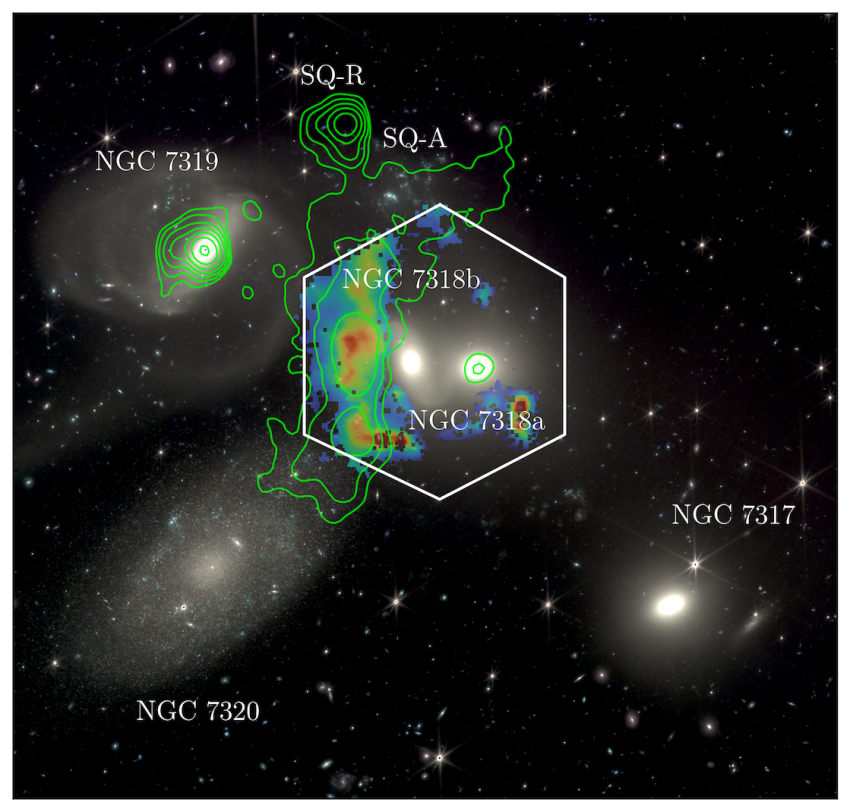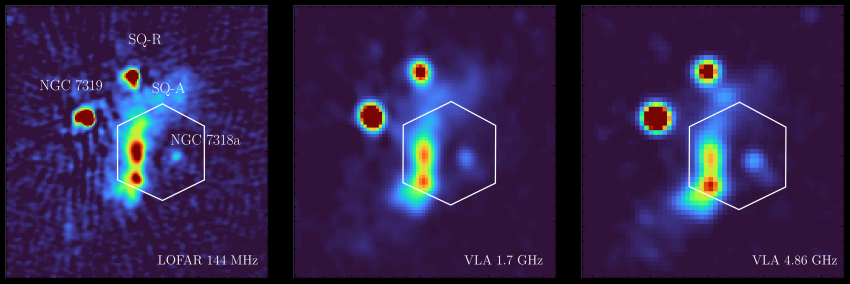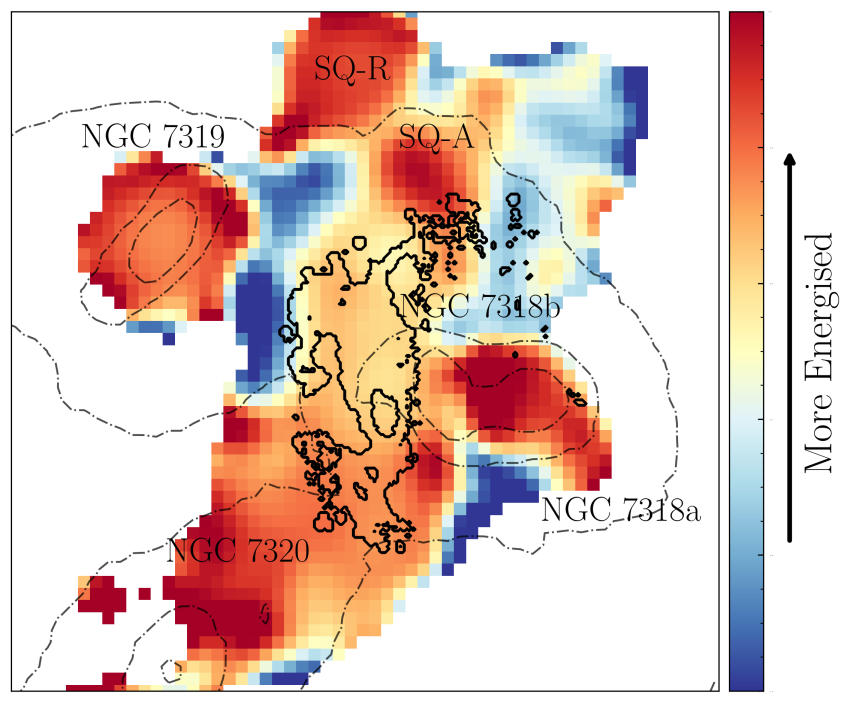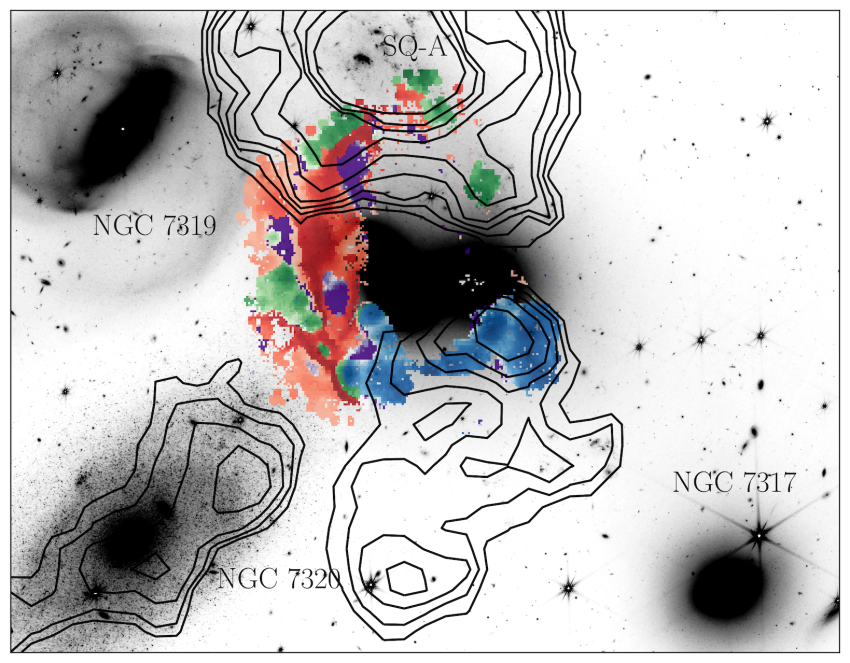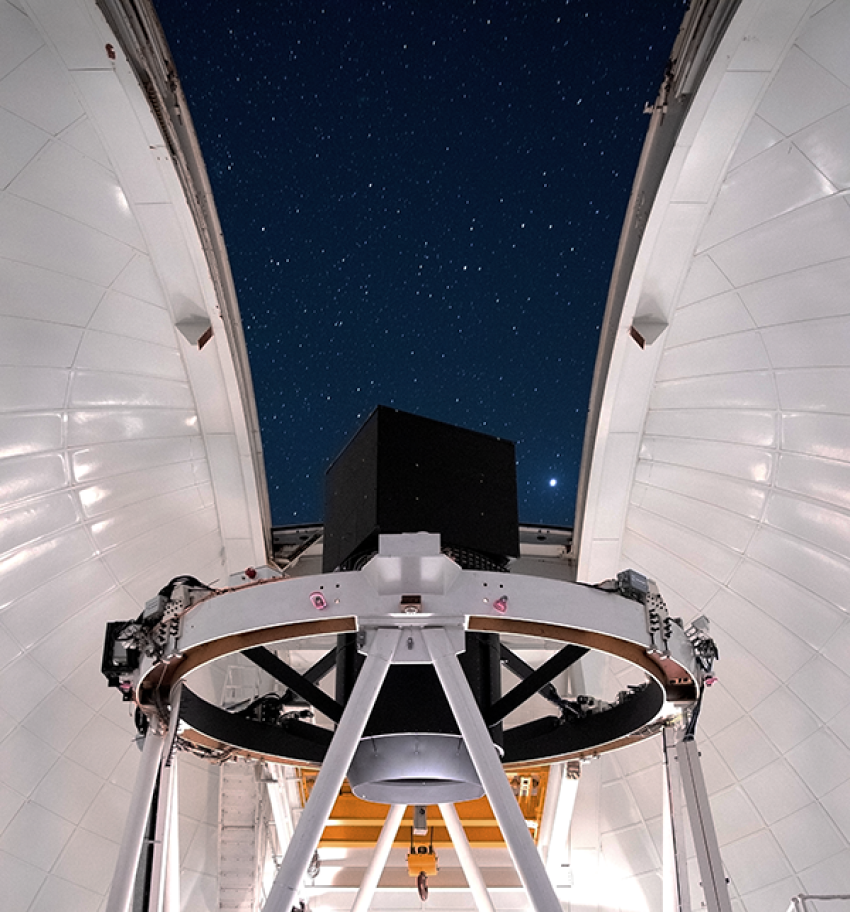A massive collision of galaxies sparked by one travelling at a scarcely-believable 2 million mph (3.2 million km/h) has been seen in unprecedented detail by one of Earth's most powerful telescopes.
The dramatic impact was observed in Stephan's Quintet, a nearby galaxy group made up of five galaxies first sighted almost 150 years ago.
It sparked an immensely powerful shock akin to a "sonic boom from a jet fighter" – the likes of which are among the most striking phenomena in the Universe.
Stephan's Quintet represents "a galactic crossroad where past collisions between galaxies have left behind a complex field of debris", which has now been reawakened by the passage of the galaxy, NGC 7318b.
The collision was spotted by a team of scientists using the first observations from the new 20-million Euro (£16.7million) William Herschel Telescope Enhanced Area Velocity Explorer (WEAVE) wide-field spectrograph in La Palma, Spain.
This cutting-edge, next generation science facility will not only reveal how our Milky Way galaxy was built up over billions of years, but also offer new insights into millions of other galaxies across the Universe.
The discovery of NGC 7318b smashing through Stephan's Quintet was observed by a team of more than 60 astronomers and has been published today in Monthly Notices of the Royal Astronomical Society.
The system is an ideal laboratory to understand the chaotic and often violent relationship between galaxies, which is why it was the focus of the first-light observation by the WEAVE Large Integral Field Unit (LIFU).
Lead researcher Dr Marina Arnaudova, of the University of Hertfordshire, said: "Since its discovery in 1877, Stephan's Quintet has captivated astronomers, because it represents a galactic crossroad where past collisions between galaxies have left behind a complex field of debris.
"Dynamical activity in this galaxy group has now been reawakened by a galaxy smashing through it at an incredible speed of over 2 million mph (3.2 million km/h), leading to an immensely powerful shock, much like a sonic boom from a jet fighter."
The international team has uncovered a dual nature behind the shock front, previously unknown to astronomers.
"As the shock moves through pockets of cold gas, it travels at hypersonic speeds – several times the speed of sound in the intergalactic medium of Stephan’s Quintet* – powerful enough to rip apart electrons from atoms, leaving behind a glowing trail of charged gas, as seen with WEAVE," Dr Arnaudova said.
However, when the shock passes through the surrounding hot gas, it becomes much weaker, according to PhD student Soumyadeep Das, of the University of Hertfordshire.
He added: "Instead of causing significant disruption, the weak shock compresses the hot gas, resulting in radio waves that are picked up by radio telescopes like the Low Frequency Array (LOFAR)."
The new insight and unprecedented detail came from WEAVE's LIFU, combining data with other cutting-edge instruments such as the LOFAR, the Very Large Array (VLA), and the James Webb Space Telescope (JWST).
WEAVE is a state-of-the-art super-fast mapping device that has been connected to the William Herschel Telescope to analyse the composition of stars and gas both in the Milky Way and in distant galaxies.
This is done with the help of a spectroscope, which reveals the elements that stars are made of by generating a bar code-style pattern within a prism of colours that make up a source of light.
It was designed and built following a multi-lateral agreement by France, Italy and the countries of the Isaac Newton Group of Telescopes partnership (the UK, Spain and the Netherlands).
Astronomers hope that WEAVE will help reveal how our galaxy formed in unprecedented detail and revolutionise our understanding of the Universe.
Dr Daniel Smith, of the University of Hertfordshire, said: "It's really neat work that Marina has put together with this large team, but this first WEAVE science paper also represents just a taste of what is to come over the next five years now that WEAVE is becoming fully operational."
Professor Gavin Dalton, WEAVE principal investigator at RAL Space and the University of Oxford, said: "It's fantastic to see the level of detail uncovered here by WEAVE.
"As well as the details of the shock and the unfolding collision that we see in Stephan's Quintet, these observations provide a remarkable perspective on what may be happening in the formation and evolution of the barely resolved faint galaxies that we see at the limits of our current capabilities."
Dr Marc Balcells, director of the Isaac Newton Group of Telescopes, said: "I'm excited to see that the data gathered at the WEAVE first light already provide a high-impact result, and I'm sure this is just an early example of the types of discoveries that will be made possible with WEAVE on the William Herschel Telescope in the coming years."
ENDS
Media contacts
Sam Tonkin
Royal Astronomical Society
Mob: +44 (0)7802 877700
Robert Massey
Royal Astronomical Society
Mob: +44 (0)7802 877699
Science contacts
Dr Marina Arnaudova
University of Hertfordshire
Soumyadeep Das
University of Hertfordshire
Dr Daniel Smith
University of Hertfordshire
Images and captions
WEAVE's view of Stephan’s Quintet
Caption: WEAVE data overlaid on a James Webb Space Telescope image of Stephan's Quintet, with green contours showing radio data from the Low Frequency Array (LOFAR) radio telescope. The orange and blue colours follow the brightness of Hydrogen-alpha obtained with the WEAVE LIFU, which trace where the intergalactic gas is ionised. The hexagon denotes the approximate coverage of the new WEAVE observations of the system, which is 36 kpc wide (similar in size to our own galaxy, the Milky Way).
Credit: University of Hertfordshire
Caption: Radio observations of Stephan's Quintet at different frequencies, taken by the Low Frequency Array (LOFAR) and the Very Large Array (VLA). The red colours indicate strong radio emission coming from the shock front, as well as from some of the galaxies in the group and beyond.
Credit: University of Hertfordshire
Caption: An image revealing the age of high-energy plasma in Stephan's Quintet, as captured by radio observations with the VLA and LOFAR. The blue colours indicate older, low-energy plasma, while the orange and yellow areas mark regions that are being actively energised. The thin, dashed lines outline the location of the galaxies in the group, while the black solid lines trace the shock region identified with WEAVE data, which perfectly matches the areas where this plasma is being re-accelerated by the collision between NGC 7318b and the group.
Credit: University of Hertfordshire
Caption: WEAVE decomposition of gas in Stephan's Quintet, overlaid on a JWST image. The red highlights gas shocked by the collision, while green and blue shows star-forming regions. The purple areas represent bubbles with an unknown origin. The black contours show neutral Hydrogen, and its location relative to the shocked gas (in red) suggests that is where it comes from.
Credit: University of Hertfordshire
Caption: The WEAVE prime-focus corrector and positioner at the William Herschel telescope in La Palma, Spain.
Credit: ING
Further information
The paper 'WEAVE First Light observations: Origin and Dynamics of the Shock Front in Stephan's Quintet', by Dr Marina Arnaudova et al. has been published in Monthly Notices of the Royal Astronomical Society.
*This is estimated to be ~440km/s.
Notes for editors
About WEAVE
In 2016, a multi-lateral agreement to design and build WEAVE was signed by the countries of the Isaac Newton Group of Telescopes (ING) partnership (the UK, Spain and the Netherlands), joined by France and Italy, with each country contributing major components as listed below, and with the ING providing auxiliary systems and overall project management.
The consortium is led by Gavin Dalton from the University of Oxford and RALSpace as Principal Investigator, Scott Trager from University of Groningen as Project Scientist, Don Carlos Abrams from ING as Project Manager, and Chris Benn from ING as Instrument Scientist.
The main components of WEAVE are:
- Fibre positioner, developed by the University of Oxford in the UK, with support from the Instituto de Astrofísica de Canarias (IAC) in Spain.
- Prime-focus system, designed by ING, IAC and SENER, provided by the IAC and manufactured by SENER. Support from Konkoly Observatory (HU). Lenses were polished by KiwiStar in New Zealand, funded from STFC, NOVA, INAF, IAC and ING, and mounted at SENER Aeroespacial (ES) by SENER and ING.
- Spectrograph, built by NOVA in the Netherlands with optical design by RAL Space in the UK, optics manufactured at INAOE (MX) and with support from INAF (IT) and the IAC.
- Field rotator, provided by IAC and manufactured by IDOM (ES). Optical fibres, provided by the Observatoire de Paris in France, manufactured in France, Canada and USA.
- LIFU, built by NOVA (NL).
- CCD detectors system, provided by Liverpool John Moores University in the UK. Data processing, analysis and archiving led by the University of Cambridge (UK), IAC (ES) and FGG-INAF (IT) respectively.
- Observatory control system, built by the ING.
WEAVE's construction has been funded by the Science and Technology Facilities Council (STFC, UK), the Netherlands Research School for Astronomy (NOVA, NL), the Dutch Research Council (NWO, NL), the Isaac Newton Group of Telescopes (ING, UK/NL/ES), the Instituto de Astrofísica de Canarias (IAC, ES), the Ministry of Economy and Competitiveness (MINECO, ES), the Ministry of Science and Innovation (MCI, ES), the European Regional Development Fund (ERDF), the National Institute for Astrophysics (INAF, IT), the French National Centre for Scientific Research (CNRS, FR), Paris Observatory – University of Paris Science and Letters (FR), Besançon Observatory (FR), Region île de France (FR), Region Franche-Comté (FR), Instituto Nacional de Astrofísica, Óptica y Electrónica (INAOE, MX), National Council for Science and Technology (CONACYT, MX), Lund Observatory (SE), Uppsala University (SE), the Leibniz Institute for Astrophysics (AIP, DE), Max-Planck Institute for Astronomy (MPIA, DE), University of Pennsylvania (US), and Konkoly Observatory (HU).
About the William Herschel Telescope
The William Herschel Telescope (WHT) is operated on the island of La Palma by the Isaac Newton Group of Telescopes (ING) in the Spanish Observatorio del Roque de los Muchachos of the Instituto de Astrofísica de Canarias (IAC). The ING is funded by the Science and Technology Facilities Council (STFC-UKRI) of the United Kingdom, the Nederlandse Organisatie voor Wetenschappelijk Onderzoek (NWO) of the Netherlands, and the IAC in Spain. IAC's contribution to the ING is funded by the Spanish Ministry of Science, Innovation and Universities.
About the Royal Astronomical Society
The Royal Astronomical Society (RAS), founded in 1820, encourages and promotes the study of astronomy, solar-system science, geophysics and closely related branches of science.
The RAS organises scientific meetings, publishes international research and review journals, recognises outstanding achievements by the award of medals and prizes, maintains an extensive library, supports education through grants and outreach activities and represents UK astronomy nationally and internationally. Its more than 4,000 members (Fellows), a third based overseas, include scientific researchers in universities, observatories and laboratories as well as historians of astronomy and others.
The RAS accepts papers for its journals based on the principle of peer review, in which fellow experts on the editorial boards accept the paper as worth considering. The Society issues press releases based on a similar principle, but the organisations and scientists concerned have overall responsibility for their content.


